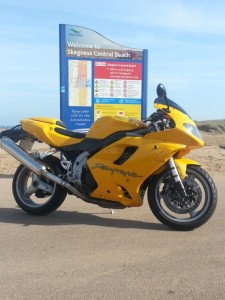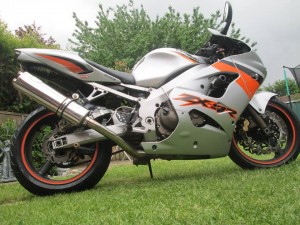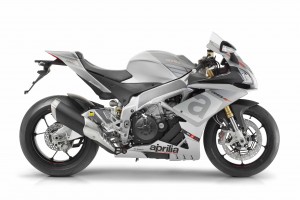This time last year I compared the first ‘proper’ motorcycle I ever owned (the hair-raisingly bonkers 1,000cc Laverda Jota) with three of my most recent bikes; the 650cc Suzuki Bandit, the 850cc Honda VFR, and the (then) very recently purchased Triumph Daytona 955i.
So, exactly 12 months on, it’s an appropriate time to revisit this subject.
Since I wrote last year’s comparisons, I’ve done a lot of bike mileage.
I’ve put 25,000 miles on the Daytona in the last year.
I had also put 8,000 miles on the Honda VFR (before I sold it).
In June last year I bought a Kawasaki Ninja ZX9R,
and began running that in conjunction with the same Triumph Daytona 955i.
And I’ve put 8,000 miles on that bike!
The whole reason for getting the Ninja/ZX9R was to take the strain off the Daytona, but doing all my local running around and commuting on the (much lower mileage) Ninja.
I knew the ZX9R, it belonged to someone in the area that I’m friendly with. I managed to scrape together the cash and soon it was mine.
Right from the outset of the Ninja arriving I still preferred the Daytona.
There is something about the lightweight triple-cylinder racing engine that was so enthusiastic about the job than the Ninja’s hefty lump of a 4-cylinder engine.
In the last 12 months I have had a very enjoyable round-Spain tour on the Daytona.
If I had a choice, I would still be giving all my mileage to the Offensively Yellow machine.
But I didn’t have the choice, because I wanted to keep the Daytona.
And that meant keeping the Daytona’s mileage as low as I could manage.
So I stuck to my plan.
The Ninja, if I’m honest, is actually a very tidy machine to commute on.
It’s got quite a lot of grunt, it has excellent brakes (both front and rear), it’s well balanced, and it’s very responsive.
And, unexpectedly, it’s very nimble in extreme congestion.
The Ninja is also capable of being quite quick.
I’m very lucky that the ZX9R/Ninja I have is the last model, and one of the very last machines of its type, to roll off the production line.
The ZX9R engine is 899cc; it delivers 143bhp and has an advertised top speed of more than 175mph (which we all know to be complete bollocks, because manufacturers have ways of getting top speeds out of a car/bike, that members of the public don’t have).
But I have easily achieved 150mph.
And the engine/gearbox/clutch package is unbelievably sweet to operate, at any speeds.
If I have one adverse observation with the Ninja, it is that I have to *make* it go faster in order to go faster.
What I mean is I have to really open my wrist to make progress quickly.
However the weight of the Ninja (183Kg), coupled with its nice nimbleness, and its beautiful balance makes the ZX9R one of the nicest commuters I’ve had the good fortune to sit on.
And that brings me to the Daytona.
I am biased.
The Daytona is the best bike I’ve ever owned.
If Triumph still made these, I’d be selling the Ninja and my Daytona this spring, and buying the latest model Daytona 955i.
But they don’t make them anymore.
Sure, I could go out and buy a brand new Triumph Daytona 675R, but why would I want to?
I want a bike in the 1,000cc range.
Why would I consider downsizing the engine?
I wouldn’t, obv.
The Triumph Daytona is everything that I like to have in a supersports bike.
The 955i is very swift, it’s well-balanced, it has good manners (almost all of the time), it is tremendously nimble.
And it has a character.
On the downside, the Daytona is a bike that encourages poor behaviour.
The 955cc engine will seductively lure the unwary motorbike rider in to potentially licence-losing territory.
Unlike the Ninja, one needs to make no special physical effort to encourage the Daytona go quicker.
It’s too easy to get lulled in to the belief that one is just pootling along, and then check the speedometer, to realise that one has (unknowingly) come on the edge of extremely high speeds.
The bike just does it.
It seems to ease itself through faster and faster speeds and all of a sudden the rider will look down and say, ‘How the hell did I get this quick?’
Indeed.
The Daytona is a very swift supersports bike.
She’s also a very comfortable machine to tour on – my 1,400-mile round-Spain tour last year was great fun on this little bike.
The 955i has tremendous character (as well as having a very distinctive noise from that sweetly-engineered triple-cylinder engine).
And the Daytona looks good.
The single swing arm shows off the bike to its very best.
Weighing in at slightly more than the ZX9R (191Kg v the Kawasaki’s 183Kg), the 147bhp Daytona should feel heavier than it does, and it should feel heavier than the Ninja.
But it doesn’t.
After changing from one bike to the other, the Daytona has caught me out once or twice, especially on sharpish bends, when she has behaved in a way that the ZX9R hasn’t.
I put this down to the contrasting differences in the way weight has been distributed around the two frames.
The Ninja is quicker (even easier) to settle in to a line through a sharpish bend. She just feels more grounded. Planted on a line.
The Daytona needs more body-shifting from the rider to achieve the same line. Otherwise you’ll be sitting in the hedge wondering how you came to be there.
If they were horses, I’d say the ZX9R/Ninja is a part-bred performance horse. The Daytona is a very coltish Thoroughbred.
But appreciating the difference between these two bikes is part of the utter joy of owning both of them.
I would give the Kawasaki Ninja/ZX9R an easy 9.7 out of 10.
I would give the Triumph Daytona 955i 9.8 out of 10.
Maybe I’ll change bikes again this year.
Maybe I’ll change one. Maybe I’ll change both.
I do quite fancy the look of the RSV4R.
But for now, I love having these bikes.
And I love the differences between them.



I had an 800cc Suzuki bike for a number of years. Well, the engine, and it was encased in the bodywork of a Suzuki Alto car. The acceleration was absolutely fantastic, could beat anything away from the lights. Until halfway across the junction when it bottomed out.
You is a mad eejit!
Act your age, man!